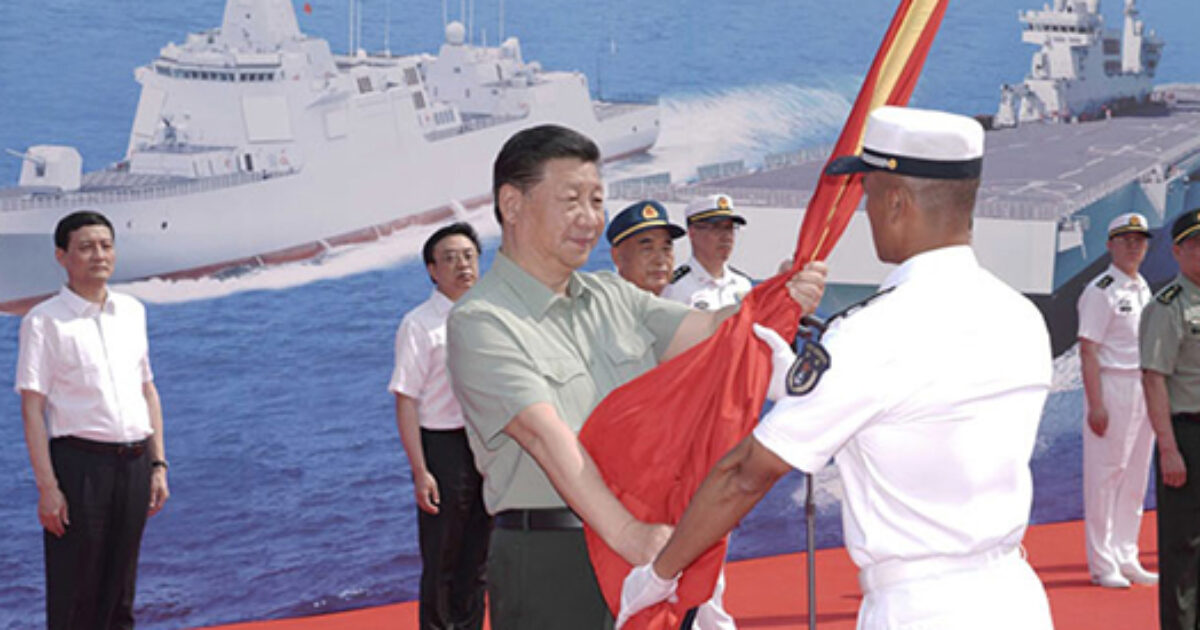China’s Underwater Glider Haiyi, image courtesy of SPS Naval Forces.
Through the Belt and Road Initiative (BRI), China sought to assert its global dominance. As technological advancements continue, China is expanding its quest for dominance into new domains such as outer space and the deep sea, where undersea warfare has become a critical arena for power projection.
The Indo-Pacific region, particularly the South China Sea (SCS), has become a focal point for geopolitical leverage. China has significantly expanded its underwater capabilities, using the SCS as a critical area of operations. As China’s presence extends across the broader Indo-Pacific, its growing influence raises concerns about its implications for global security and the strategic balance in the region.
Undersea warfare, which includes the use of submarines, torpedoes, mines, and underwater drones, is increasingly central to modern military strategy. These assets are used for surveillance, intelligence gathering, and neutralizing underwater infrastructure. Submarines, whether conventional (SSKs) or nuclear-powered (SSNs and SSBNs), play key roles, with SSNs and SSKs particularly valued for their stealth and operational flexibility. Torpedoes and mines complement these operations as cost-effective yet deadly weapons, while advanced detection technologies such as SOSUS and SONAR systems remain essential for anti-submarine warfare (ASW).
China’s ambitions in undersea warfare are reflected in its expanding fleet, which includes 59 submarines, advanced torpedoes, and surveillance technologies like quantum radar. These developments, along with large-scale military exercises in the SCS, underline China’s intent to assert dominance in the region’s undersea domain and challenge U.S. naval influence.
The importance of undersea assets is not confined to military applications alone. China’s strategy integrates undersea telecommunications, data centers, and resource extraction, forming part of its broader Digital Silk Road initiative. This expansion into the digital and maritime domains is designed to secure critical minerals and data dominance, aligning with China’s Five-Year Plans which emphasize ocean observation technologies, remote sensing, and global monitoring networks. The growing competition for these resources, especially in deep-sea mining, highlights the intersection of China’s maritime and digital strategies. As global demand for minerals essential to digital infrastructure increases, seabed mining becomes a key area of competition. China’s control over critical resources in international waters and Exclusive Economic Zones (EEZs) further intensifies geopolitical tensions.
In parallel, China’s undersea warfare capabilities are bolstered by technological advancements in military-civil fusion and partnerships with Russia, particularly in submarine technology. Innovations like air-independent power and nuclear-powered platforms illustrate China’s growing prowess, though challenges remain in propulsion technologies, noise reduction, and ASW capabilities. The People’s Liberation Army Navy (PLAN) also emphasizes seabed warfare, particularly in safeguarding or potentially sabotaging undersea cables, which are vital to global communications and economic stability.
The integration of underwater digital infrastructure into China’s strategic goals raises significant environmental, security, and governance concerns. Projects such as the “underwater Great Wall” of sensors in the SCS—designed for oceanographic research, environmental monitoring, and tactical surveillance—reflect China’s growing emphasis on undersea digital infrastructure. While these sensors could help monitor climate change and improve environmental efficiency in data centers, they also deepen geopolitical rivalries, particularly in contested areas like the SCS. The governance of such technologies, especially in global commons, remains a complex issue, with the potential for disputes over data protection, infrastructure security, and the environmental impacts of such large-scale undersea projects.
The strategic militarization of the SCS, coupled with its economic and geopolitical value, highlights the region’s critical role in global security. Joint military maneuvers, such as the U.S.-Japan PASSEX in 2017 and the UK-France FONOP near the Spratly Islands in 2018, demonstrate the international community’s efforts to counter China’s growing dominance and preserve open sea lanes. The continuing contest over the SCS exemplifies the interplay of military, economic, and political forces shaping global geopolitics.
Despite China’s advancements, challenges remain. The PLAN faces inefficiencies in organization, personnel training limitations, and technological gaps compared to the U.S. Navy. Analysts emphasize the importance of undersea superiority for the U.S. and its allies, particularly within the context of great power competition with China. Strengthening alliances such as AUKUS and enhancing U.S. naval operations in the undersea domain are seen as crucial for maintaining regional stability and countering China’s growing capabilities.
As technological advancements drive rivalries into new domains, including outer space and the deep sea, undersea warfare has emerged as a vital arena for power projection. This form of warfare is increasingly focused on defending coastal waters, marine assets, and Sea Lanes of Communication (SLOCs) from threats posed by submarines and other undersea systems. The contest for control of undersea spaces will likely shape future geopolitical dynamics, particularly as China continues to expand its military and digital capabilities in the Indo-Pacific region.
China’s expanding undersea warfare capabilities and its strategic integration of digital infrastructure pose significant challenges to the global security environment. With a growing focus on seabed mining, undersea telecommunications, and military operations, China is not only reshaping the undersea battlespace but also redefining the strategic importance of maritime and digital domains. As competition intensifies, addressing the environmental, economic, and governance issues arising from this expansion will be critical to maintaining global stability. For the U.S. and its allies, countering China’s growing influence in the undersea domain will require innovation, stronger alliances, and a comprehensive strategy to secure vital sea lanes and maintain technological superiority.
The post China’s Expanding Undersea Warfare and Its Strategic Threat to the U.S. appeared first on The Gateway Pundit.











